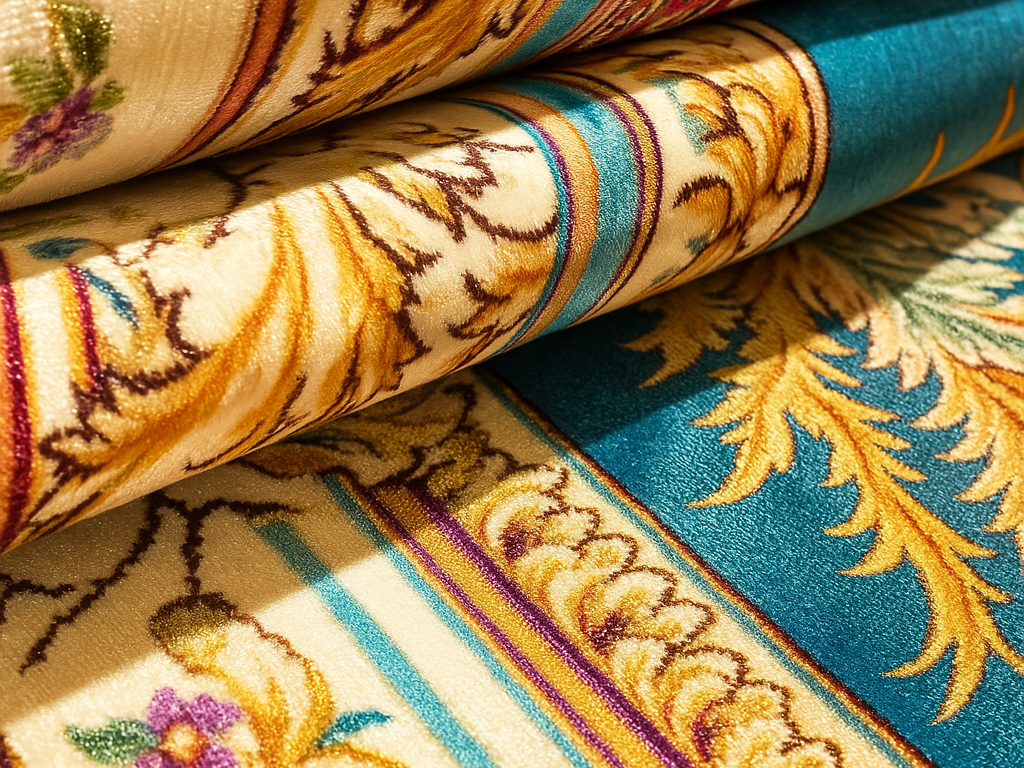Tanto si está renovando su salón como si está amueblando una nueva casa, elegir la alfombra adecuada para sus suelos de madera es más que una decisión de estilo: es una salvaguarda de la belleza que hay bajo sus pies. Con innumerables materiales, tipos de soporte y opciones de acolchado, navegar por el pasillo de las alfombras puede resultar abrumador. Es por eso que nuestra guía entra en acción: le guiaremos a través de qué hace que una alfombra sea segura para los suelos de madera, desde materiales suaves y soportes sin PVC hasta el papel esencial de los acolchados para alfombras y las certificaciones.
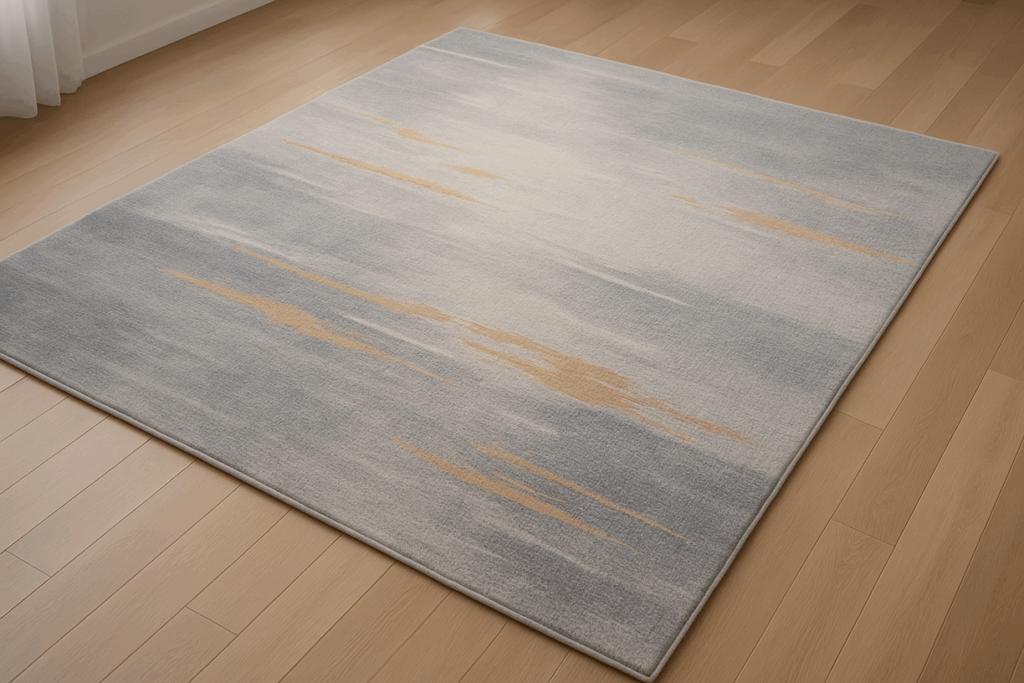
Al final de este post, no sólo comprenderá la los mejores materiales para alfombras para proteger sus suelos, sino también cómo elegir...una alfombra elegante y respetuosa con el suelo.
1. Por qué la elección de la alfombra es importante para los suelos de madera dura
Elegir la alfombra adecuada para el suelo de madera no es sólo una decisión de estilo, es un compromiso para preservar la belleza del suelo. Un material de alfombra inadecuado puede atrapar la humedad, liberar tintes o desgastar los acabados. Con el tiempo, sutiles decoloraciones o micro arañazos se convierten en daños duraderos. Mientras tanto, la alfombra adecuada trabaja silenciosamente: aterriza el espacio, suaviza los pasos y fortalece tanto su suelo como su inversión. En cierto sentido, la alfombra actúa como guardián, no sólo como decoración.
Lectura relacionada: ¿Cómo elegir la alfombra adecuada para su salón?
2. El material importa: ¿Cuál es el mejor?
Cuando se trata de alfombras para madera dura, el material no es sólo una opción de lujo, es un defensor de primera línea. Desgranemos los puntos fuertes (y las pequeñas debilidades) de cada opción común.
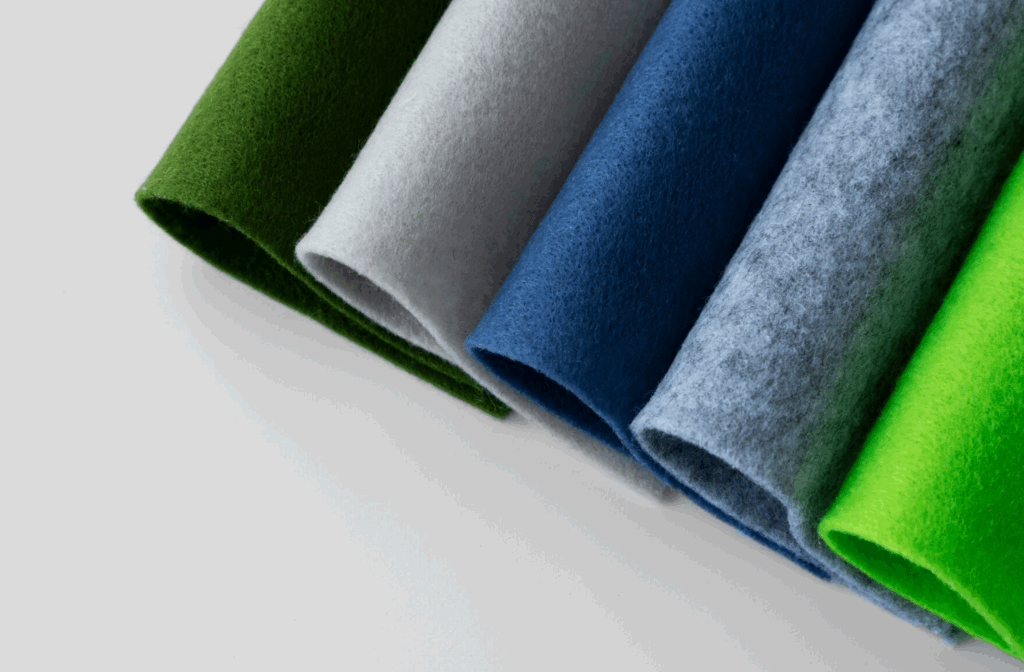
Lana: El mejor protector
Lana sigue siendo el estándar de oro entre los materiales naturales, y con razón. Es duradero, suave al tacto, naturalmente resistente a las manchas e incluso hipoalergénico, por lo que mima los pies y protege el suelo. Sus gruesas fibras actúan como un cojín, protegiendo la madera de arañazos y absorbiendo el impacto de la vida diaria. Intente encontrar alfombras con tejidos apretados y lana de alta densidad para una máxima longevidad.
Algodón: Fresco, limpio y desenfadado
El algodón es transitorio pero versátil. Ligero y a menudo lavable a máquina, es perfecto para espacios ajetreados como cocinas o salas de juegos donde los derrames son una realidad semanal (¡o diaria!). Como es más suave y menos denso que la lana, las alfombras de algodón se benefician enormemente de un protector de alfombra bien colocado para estabilizarlas y proteger el suelo.
Fibras naturales (yute, sisal): Orgánicas y con textura
Si lo que te gusta es la estética cruda y sostenible, el yute y el sisal cumplen. Estos materiales son ecológicos y baratos, pero su textura gruesa requiere un cuidado especial. Sin una capa inferior suave, pueden desgastar sutilmente el suelo con el tiempo. Utilice una almohadilla de fieltro o algodón debajo para preservar tanto el suelo como la fibra.
Sintéticos (poliéster, polipropileno, nailon): Héroes resistentes
Las alfombras sintéticas destacan por su durabilidad y facilidad de limpieza, una opción ideal para mascotas, familias o espacios de alquiler. Materiales como el polipropileno y el PET suelen ser resistentes a las manchas, tienen poco pelo y están diseñados para un uso intensivo. Son económicos y fáciles de mantener, pero carecen de la suavidad natural de la lana y algunos pueden contener COV, dependiendo de su producción. Utiliza un acolchado con certificación ecológica para estar seguro.
La seda: Elegante pero frágil
Alfombras de seda pertenecen a la categoría “mira pero no camines”. Reservadas para espacios formales o paredes, son lujosas a primera vista, pero delicadas bajo los pies. La tensión mecánica puede deshilachar las fibras rápidamente, lo que las convierte en una mala elección para zonas activas con madera noble debajo.
Voces del mundo real
Expertos en interiores y editores de estilo de vida se hacen eco de los puntos fuertes y las limitaciones de estos materiales. Un antiguo redactor de interiores de Livingetc lo explica así:
“La lana es el estándar de oro: atemporal, duradera y naturalmente resistente a las manchas. Si buscas algo más asequible, el algodón es un favorito de bajo mantenimiento, el yute y el sisal añaden una textura orgánica y fresca, y los sintéticos como el nailon están diseñados para soportar los momentos más desordenados de la vida”.”
3. Por qué son importantes las alfombrillas (aunque estén entre bastidores)
Puede que los protectores de alfombras no estén a la vista, pero no por ello son menos importantes, especialmente cuando se trata de proteger suelos de madera. Veamos cómo la alfombrilla correcta (y la incorrecta) puede alterar drásticamente la longevidad tanto de la alfombra como del suelo.
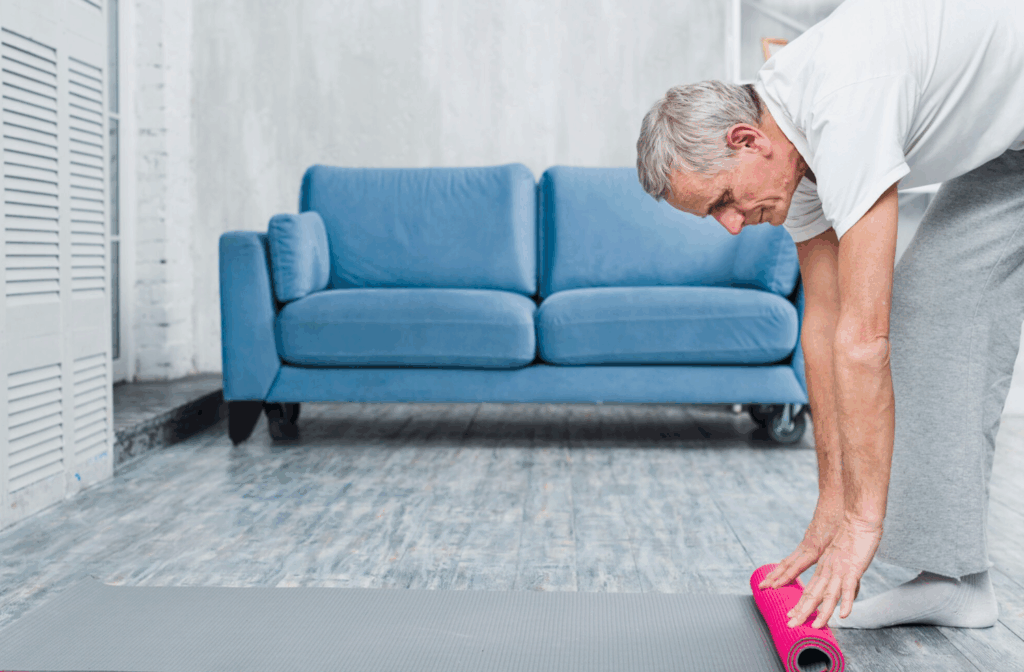
Ventajas esenciales de los protectores de alfombras
- Estabilidad y Seguridad: Los acolchados para alfombras mantienen sus suelos seguros y sus alfombras en su sitio. Rachel Fasciani, de STARK Carpet, subraya que no es poca cosa: evitan los resbalones, reducen las rozaduras, protegen las superficies e incluso recogen el polvo para prolongar la vida útil de la alfombra.
- Protección de suelos y alfombras: Un acolchado de alta calidad actúa como amortiguador, absorbiendo los impactos y reduciendo la fricción que desgasta tanto el acabado de la madera como las fibras de la alfombra. También evita la transferencia de tintes o las manchas, problemas habituales en alfombras sin acolchado o con un acolchado incorrecto.
- Amortiguación y confort: Las almohadillas no sólo protegen, sino que aumentan el confort bajo los pies. Las almohadillas de fieltro añaden suavidad y mejoran la acústica, lo que es especialmente agradable bajo alfombras densas o pesadas.
- Facilidad de limpieza y Mantenimiento: El flujo de aire debajo de las alfombras ayuda a las aspiradoras a limpiar con mayor eficacia. Algunas almohadillas también repelen la humedad, protegiendo su madera dura de la filtración de derrames.
Elegir el material adecuado para las almohadillas es importante
He aquí un desglose de los tipos de almohadillas para alfombras y cómo combinan con la madera dura:
- Goma - Excelente agarre antideslizante; ideal para suelos duros. Elija variedades naturales o ventiladas para evitar que la humedad quede atrapada.
- Fieltro - Afelpados y acolchados, ideales cuando la comodidad y la amortiguación del sonido son prioritarias. Emparejar con caucho para mayor agarre.
- Híbrido de fieltro y goma - Lo mejor de ambos mundos: agarre, acolchado y seguridad combinados.
- PVC o caucho de baja calidad - PRECAUCIÓN RÁPIDOS: suelen ser baratos y potencialmente peligrosos. Pueden dejar residuos, causar manchas o incluso deformar los suelos.
Lectura relacionada: Guía de 6 pasos para deshacerse de los escarabajos de las alfombras
4. Respaldo y construcción: Los protectores ocultos
Bajo las fibras y el dibujo, el soporte y la construcción de una alfombra protegen silenciosamente la madera dura que hay debajo, a menudo más importante que lo que se ve por encima.
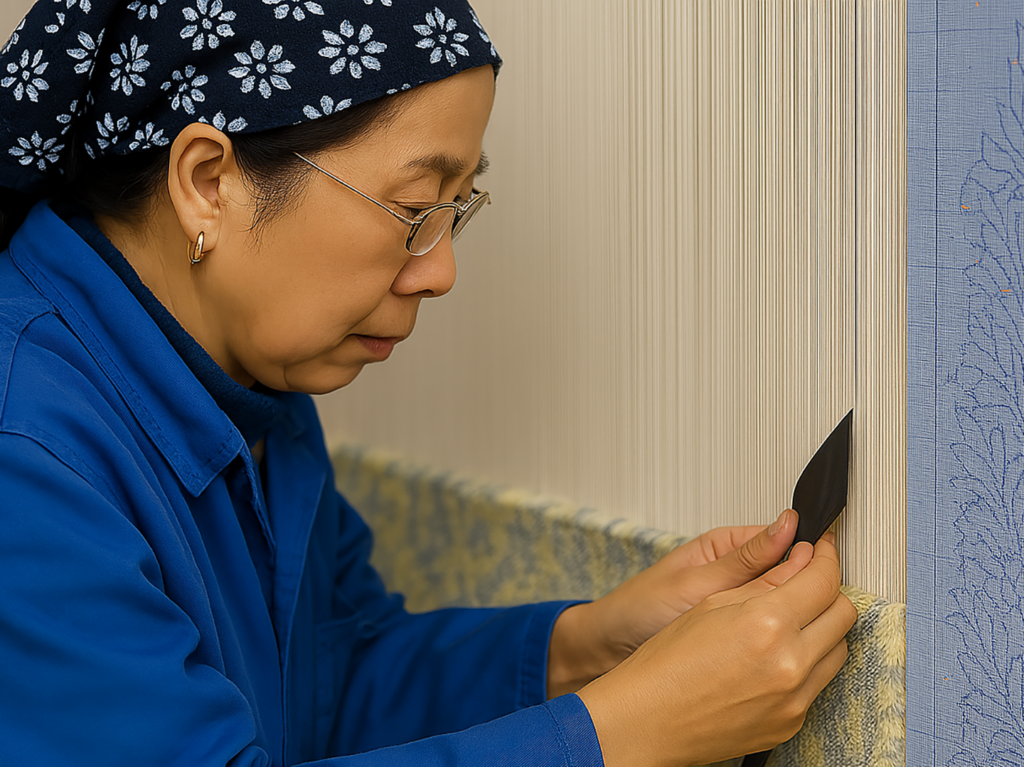
Materiales de soporte que pueden dañar el parquet
- Soporte de yute puede parecer natural, pero es sorprendentemente abrasivo. Las fibras ásperas pueden rayar y desgastar la madera, sobre todo en zonas muy transitadas, a pesar de la idea errónea de que natural es igual a seguro.
- Soporte de caucho o látex, Aunque son antideslizantes, pueden atrapar la humedad y contener aditivos químicos como plastificantes. Estos compuestos pueden decolorar o adherirse al acabado del suelo y, en algunos casos, incluso deformar la madera.
- Vinilo o PVC respaldo presenta riesgos similares. No transpirables por naturaleza, retienen la humedad y pueden lixiviar plastificantes, lo que provoca el amarilleamiento o la formación de burbujas en la superficie.
- Soportes adhesivos o pegajosos son un no-go. Pueden adherirse directamente al acabado de la madera y arrancarlo al levantar la alfombra sin previo aviso.
¿Qué soportes son compatibles con la madera dura?
- Fondos tejidos destacan por su transpirabilidad y suave contacto. Permiten que circule el aire, reduciendo la acumulación de humedad al tiempo que ofrecen una superficie lo suficientemente suave como para que la madera dura ‘respire’.’
- Fibras vegetales suaves o soporte de fieltro añaden una acogedora capa de protección que amortigua el suelo y amortigua el sonido, sin entrar en contacto abrasivo con la superficie dura.
- Soporte de caucho natural, al no contener aditivos nocivos, proporciona una excelente tracción sin manchar ni dañar el acabado de la madera, lo que las convierte en una alternativa más segura que el caucho sintético.
Construcción y tejido: Más allá de la piel
La forma en que está construida una alfombra -su tejido y estructura- también influye en la protección a largo plazo:
- Alfombras planas y de pelo corto, especialmente las tejidas a mano, como los kilims o las dhurries, ofrecen una excelente circulación del aire y un mínimo de pelo donde esconder la suciedad. Son menos propensos a atrapar la suciedad y a menudo no necesitan respaldo adicional.
- Alfombras densas y tupidas -como las piezas anudadas a mano- mantienen la forma, evitan el desprendimiento y ejercen menos fricción sobre el suelo. Su estructura de calidad les ayuda a mantenerse en su sitio sin necesidad de un soporte agresivo.
Lectura relacionada: Cómo se fabrican las alfombras: Del hilo al suelo
5. Certificaciones que garantizan la seguridad
Las certificaciones ofrecen una verdadera garantía:
- Busque Sin PVC y bajo en COV especialmente importantes tanto para su salud como para los acabados de sus suelos.
- Certificaciones ecológicas como FSC, GreenGuardo Conformidad con LEED-garantizar tanto la sostenibilidad como una química interior más segura (a menudo, para fibras naturales y tintes).
- Aunque no es frecuente encontrar sellos específicos que indiquen que la madera es segura para las alfombras, la transparencia de los fabricantes sobre los materiales de soporte (por ejemplo, “caucho natural” o “soporte de fieltro”) es un sustituto sólido.
Las señales de certificación no son llamativas, pero hablan más alto que las tendencias cuando el objetivo es la seguridad a largo plazo.
6. Consejos para alargar la vida de alfombras y suelos
Mantener la belleza y durabilidad de sus suelos de madera y Alfombras Valhak requiere un cuidado y una atención constantes. Adoptando las siguientes prácticas, puede asegurarse de que tanto su suelo como sus alfombras se mantengan en excelentes condiciones durante años.
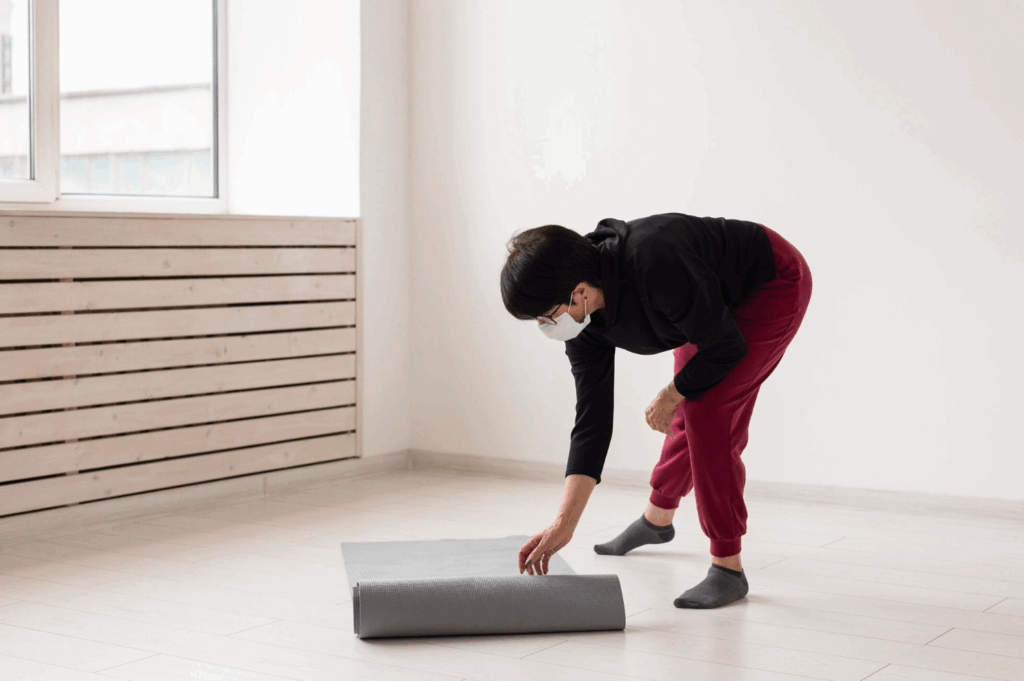
Política de no calzarse dentro de casa
La suciedad, la arenilla y la humedad del calzado de exterior pueden ser abrasivas y perjudiciales tanto para las alfombras como para los suelos de madera. Establecer una política de no usar zapatos en interiores ayuda a minimizar la introducción de estos elementos, reduciendo el desgaste del suelo y las alfombras.
Utilice protectores de alfombras de alta calidad y seguros para el suelo
Elegir el cojín de alfombra adecuado es crucial para proteger sus suelos de madera. Opte por cojines fabricados con materiales naturales como el fieltro o el caucho natural, que proporcionan amortiguación y evitan resbalones sin dañar el acabado del suelo. Evite los acolchados con PVC o adhesivos, ya que pueden decolorarse o pegarse al suelo con el tiempo.
Aspire y gire las alfombras con regularidad
Aspirar con frecuencia elimina la suciedad y los restos que pueden causar abrasión y matidez. Utilice una aspiradora con una barra batidora o un cepillo giratorio para una limpieza profunda, pero asegúrese de que está ajustada a una altura que no dañe las fibras de la alfombra. Además, rotar las alfombras cada pocos meses ayuda a distribuir el desgaste uniformemente y evita que se decoloren por la exposición a la luz solar.
Atienda rápidamente los derrames y las manchas
Los accidentes ocurren, pero una actuación rápida puede evitar daños permanentes. Seque las manchas inmediatamente con un paño limpio y absorbente; nunca frote, ya que podría hacer que la mancha se hiciera más profunda. Para la mayoría de las manchas, una mezcla de jabón suave para vajilla y agua puede ser eficaz. Pruebe siempre cualquier solución limpiadora en una zona pequeña y discreta.
Limpieza a fondo periódica
Incluso con un aspirado regular, la limpieza en profundidad es esencial para eliminar la suciedad incrustada y los alérgenos. Dependiendo del material de la alfombra, esto puede implicar servicios de limpieza profesionales o el uso de un limpiador de vapor en casa. Asegúrate de seguir las instrucciones de cuidado del fabricante para evitar dañar la alfombra.
Proteja las zonas de tráfico intenso
En zonas con mucho tránsito de personas, considere la posibilidad de utilizar alfombrillas o alfombras adicionales para proteger el suelo y las alfombras principales. Pueden absorber los impactos y reducir la cantidad de suciedad y humedad que llega a la alfombra principal y a la superficie del suelo.
Mantenga un clima interior óptimo
Los suelos de madera son sensibles a los cambios de humedad y temperatura. Utilice un humidificador o deshumidificador para mantener los niveles de humedad interior entre 30% y 50%. Esto ayuda a evitar que la madera se expanda o contraiga, lo que puede provocar deformaciones o grietas.
Utilice protectores para muebles
Pesado muebles pueden abollar o rayar los suelos de madera. Coloque almohadillas de fieltro en las patas de sillas, mesas y otros muebles para distribuir el peso uniformemente y evitar el contacto directo con el suelo. Compruebe y sustituya periódicamente estas almohadillas, ya que pueden desgastarse con el tiempo.
Evitar la exposición directa al sol
La exposición prolongada a la luz solar directa puede provocar la decoloración y el deterioro tanto de las alfombras como de los suelos de madera. Utilice cortinas o persianas para limitar la exposición al sol, y considere la posibilidad de rotar las alfombras periódicamente para garantizar una exposición uniforme a la luz.
Programar inspecciones profesionales
Incluso con un cuidado diligente, es beneficioso que sus suelos de madera y alfombras sean inspeccionados periódicamente por un profesional. Los expertos pueden detectar posibles problemas a tiempo y recomendar los tratamientos o el mantenimiento adecuados para prolongar su vida útil.
7. El enfoque de Valhak: La seguridad de las alfombras se combina con el estilo
En Valhak, creemos que puede tienen tanto un diseño elegante como suelos protegidos.
- Elección del material: Preferimos las mezclas de lana de primera calidad y las bases de algodón suave: cómodas para los pies, bonitas por encima y seguras por debajo.
- Atrás: Utilizamos exclusivamente diseños con reverso de fieltro o caucho natural, sin PVC ni adhesivos nocivos. Su madera y su conciencia respirarán más tranquilas.
- Almohadillas integradas: Muchas de nuestras alfombras vienen con almohadillas híbridas de fieltro y goma de alta calidad adaptadas al peso y al pelo de cada alfombra. Sin conjeturas.
- La educación ante todo: Incluimos etiquetas de cuidado que orientan sobre el cambio de tamaño, la elección de almohadillas, la limpieza y la rotación: todos los conocimientos necesarios para conservar su hogar.
- Flexibilidad de diseño: La seguridad no se sacrifica por la estética. Desde modernas geometrías a tonos clásicos, las alfombras Valhak complementan su decoración, no comprometen sus suelos.
¿La filosofía de Valhak? La belleza necesita unos cimientos. Hemos construido la nuestra para que dure, con elegancia.
8. Conclusión
Elegir una alfombra para suelos de madera es un equilibrio de estilo con sustancia. ¿La mejor opción? Elija materiales naturales, suaves y fáciles de limpiar, como la lana o el algodón; cúbralos con almohadillas seguras y no dañinas; y cuídelos con regularidad. En Valhak, hacemos todo esto para que su espacio se mantenga elegante y protegido durante años.
9. Preguntas frecuentes
1. ¿Puede cualquier alfombra ir sobre madera dura después de añadir un acolchado?
No del todo. Algunas fibras naturales gruesas (por ejemplo, el yute sin tratar) todavía se benefician de una capa más suave para proteger los acabados, incluso con una almohadilla.
2 .¿Con qué frecuencia debo sustituir el acolchado de una alfombra?
Más o menos cada 3-5 años, o antes si pierde adherencia, se comprime o se mancha.
3. ¿Las alfombras se decoloran con la luz del sol?
Sí, tanto la luz solar directa como el calor atrapado pueden decolorar la madera. Rote las alfombras de vez en cuando para mantener el color uniforme.
4. ¿Está bien el cojín de espuma viscoelástica sobre madera dura?
Es cómodo y suave, pero asegúrese de que es ventilado y no manchan. Para zonas de uso intensivo, los híbridos de caucho y fieltro ofrecen mejor protección y agarre.
5. ¿Tengo que limpiar debajo de la alfombra?
Absolutamente. La suciedad y el polvo bajo una alfombra permanecen ocultos, pero rayan y degradan los acabados. Levántela y aspírela al menos una vez al trimestre.

